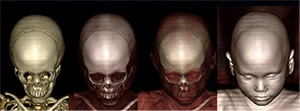Comparison of post-mortem CT and autopsy findings
Postmortem computed tomography (CT) has been gradually accepted by forensic medicine over the course of this decade. Many medico-legal institutes and departments worldwide have started to use CT as a supplementary method to forensic autopsy, as it can reveal some important findings that may be missed by autopsies, such as air embolism, tension pneumothorax, and the presence of metal fragments. However, some believe that postmortem CT can be used for screening, or, in certain cases, for determining the cause of death without performing an autopsy. In the context of the low autopsy rate, such postmortem CT examinations are increasing in Japan. However, this kind of usage is not sufficiently validated. Unfortunately, there have been many cases in which the initial postmortem CT had determined a wrong cause of death.
In our department, every corpse is subjected to multi-detector CT prior to autopsy, and board-certified radiologists from the department of radiology at Chiba University Hospital compare all radiological reports with the autopsy results. Our study findings show the true utility and limitations of postmortem CT for evaluating causes of death. Our goal is to give feedback to the society and help in the development of guidelines for the appropriate use of postmortem CT.
Yohsuke Makino

